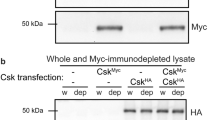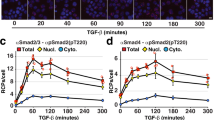Abstract
Ligand binding of multi-chain antigen receptors and hematopoietin/cytokine receptors results in rapid activation of protein tyrosine kinase (PTK)-dependent signalling molecules such as phosphatidylinositol 3-kinase (PI 3-kinase). Co-precipitation studies have shown that Src-related PTK, such as Lyn, associates with the p85 regulatory subunit of PI 3-kinase via SH2 and SH3 domain binding with their cognate ligands. More recent studies have shown that the proto-oncogene product Cbl co-precipitates with p85 following engagement of cytokine and antigen receptors. As opposed to in vitro co-precipitation studies, the yeast two-hybrid screen reveals in vivo protein – protein interactions. Using the yeast two-hybrid screen, we demonstrate an in vivo association of Lyn's SH3 and SH2 domains with the proline-rich domain of Cbl. Lyn's SH3 and SH2 domains do not interact with p85 in the yeast two-hybrid screen, as would be predicted from glutathione-S-transferase (GST) fusion protein pull-down or co-immunoprecipitation studies from whole cell lysates. However, the SH3 domain of p85 interacts with the proline-rich domain of Cbl. When yeast were transformed with catalytic Lyn, an interaction between p85's SH2 domain and Cbl occurred. From the data, we propose the following three step process of PI 3-kinase activation: (1) complexes of Lyn – Cbl and Cbl – p85 exist without ligand stimulation, (2) upon ligand binding, Lyn becomes active and phosphorylates Cbl, and (3) Cbl's tyrosine phosphorylated residue serves as a docking site for the SH2 domains of p85 – thereby stabilizing the complex and activating PI 3-kinase. The yeast two-hybrid system can be used to dissect the precise mechanisms of in vivo protein – protein interactions, including those between phosphotyrosine and SH2-containing proteins.
This is a preview of subscription content, access via your institution
Access options
Subscribe to this journal
Receive 50 print issues and online access
$259.00 per year
only $5.18 per issue
Buy this article
- Purchase on Springer Link
- Instant access to full article PDF
Prices may be subject to local taxes which are calculated during checkout
Similar content being viewed by others
Author information
Authors and Affiliations
Rights and permissions
About this article
Cite this article
Dombrosky-Ferlan, P., Corey, S. Yeast two-hybrid in vivo association of the Src kinase Lyn with the proto-oncogene product Cbl but not with the p85 subunit of PI 3-kinase. Oncogene 14, 2019–2024 (1997). https://doi.org/10.1038/sj.onc.1201031
Received:
Revised:
Accepted:
Issue Date:
DOI: https://doi.org/10.1038/sj.onc.1201031
Keywords
This article is cited by
-
Elucidation of protein interactions necessary for the maintenance of the BCR–ABL signaling complex
Cellular and Molecular Life Sciences (2020)
-
Juvenile myelomonocytic leukaemia-associated mutation in Cbl promotes resistance to apoptosis via the Lyn-PI3K/AKT pathway
Oncogene (2015)
-
JAK/STAT, Raf/MEK/ERK, PI3K/Akt and BCR-ABL in cell cycle progression and leukemogenesis
Leukemia (2004)
-
Repression of c-Cbl leads to enhanced G-CSF Jak-STAT signaling without increased cell proliferation
Oncogene (2002)
-
Beyond the RING: CBL proteins as multivalent adapters
Oncogene (2001)



